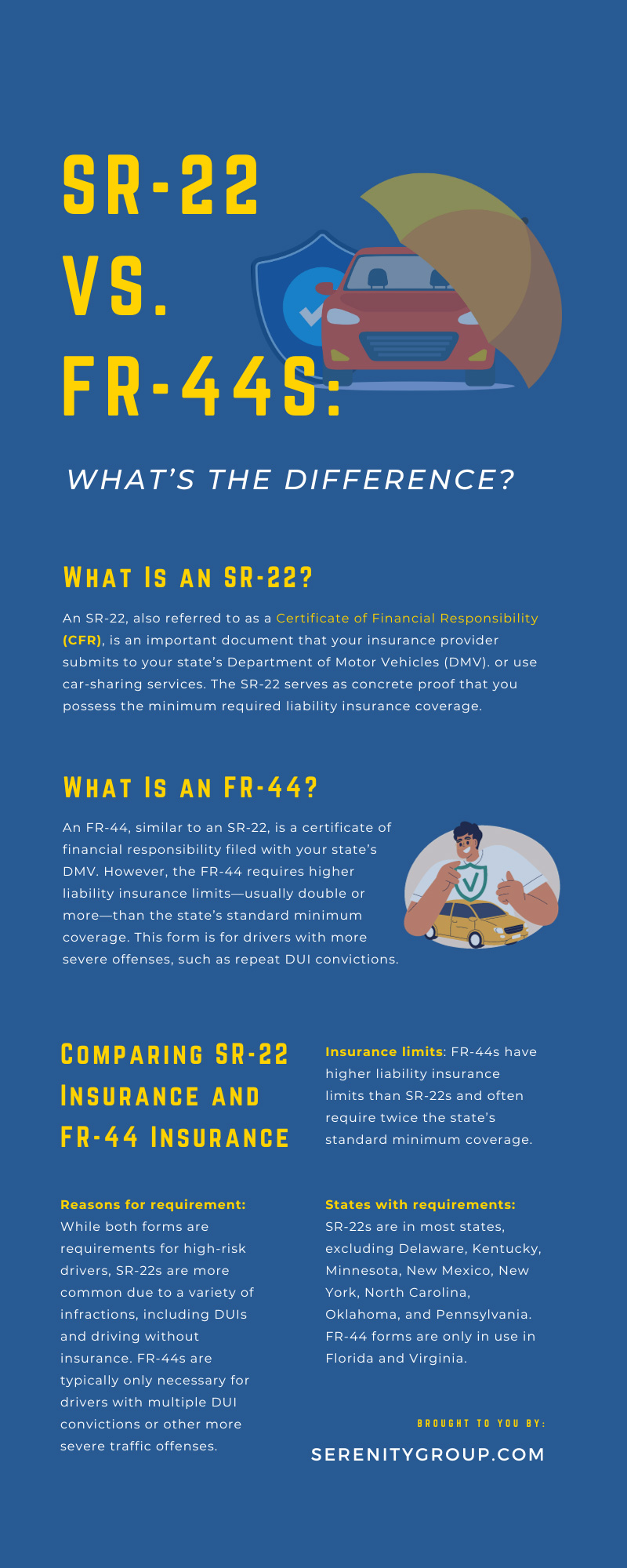SR-22 vs. FR-44s: What’s the Difference?

Navigating the world of automotive insurance can be tricky, especially when it comes to specialized forms such as the SR-22 and FR-44. If you find yourself in a situation where you need one of these, it’s crucial to understand the differences and similarities to choose the right one for your needs. In this article, we’ll dive into the nitty-gritty of SR-22 and FR-44s, discussing what they are, their uses, and how they can impact your insurance.
What Is an SR-22?
An SR-22, also referred to as a Certificate of Financial Responsibility (CFR), is an important document that your insurance provider submits to your state’s Department of Motor Vehicles (DMV). The SR-22 serves as concrete proof that you possess the minimum required liability insurance coverage. Obtaining an SR-22 is typically necessary for individuals whom the local government has classified as high-risk drivers as a result of past driving-related incidents, such as accidents or traffic violations. It’s a measure implemented by the authorities to ensure that these drivers maintain proper insurance coverage and take responsibility for their actions on the road. By requiring an SR-22, the state aims to enhance road safety, protect other drivers, and ensure that high-risk individuals are financially responsible for potential damage they cause.
Why Would You Need an SR-22?
There are several reasons why you might need an SR-22, including the following.
Driving under the influence (DUI) or driving while intoxicated (DWI) convictions: These serious offenses involve operating a vehicle while impaired by alcohol or drugs, leading to legal consequences and potential license suspension.
Repeated traffic offenses or accumulating too many points on your driving record: Consistently violating traffic laws or accumulating excessive points on your driving record can result in increased insurance rates, license suspensions, and even revocations.
At-fault accidents without insurance: Being involved in accidents where you’re at fault and lacking the proper insurance coverage can lead to significant financial liabilities and potential legal issues.
It’s important to be mindful of these factors and prioritize safe and responsible driving to maintain a clean driving record.
Which States Require an SR-22?
All states except Delaware, Kentucky, Minnesota, New Mexico, New York, North Carolina, Oklahoma, and Pennsylvania may require an SR-22 for high-risk drivers. Requirements and duration of the SR-22 can vary by state, so it’s essential to check your specific state’s laws.
What Is an FR-44?
An FR-44, similar to an SR-22, is a certificate of financial responsibility filed with your state’s DMV. However, the FR-44 requires higher liability insurance limits—usually double or more—than the state’s standard minimum coverage. This form is for drivers with more severe offenses, such as repeat DUI convictions.
Why Would You Need an FR-44?
The primary reason why drivers need an FR-44 is that they have a DUI conviction. This requirement is in place to ensure that individuals who have committed a serious offense take the necessary steps to demonstrate financial accountability. However, it’s important to note that other serious offenses, such as driving with a suspended license or driving without insurance, could also warrant FR-44 requirements. These additional circumstances emphasize the importance of responsible driving and the need for individuals to comply with legal requirements to ensure the safety of themselves and others on the road.
Which States Require an FR-44?
Currently, only Florida and Virginia require FR-44 forms, which are similar to SR-22 requirements. It’s important to note that these forms are typically requirements for convicted drivers of certain offenses, such as DUIs. It’s crucial to verify the exact details and documentation needed for FR-44 filing to ensure compliance with the specific requirements of these states. Ensure you understand the minimum liability coverage limits and the duration of the filing period.
Comparing SR-22 Insurance and FR-44 Insurance
While both SR-22 and FR-44 forms serve as proof of financial accountability, there are some important differences between the two.
- Insurance limits: FR-44s have higher liability insurance limits than SR-22s and often require twice the state’s standard minimum coverage. Generally, SR-22s only require meeting the state’s minimum liability coverage.
- States with requirements: SR-22s are in most states, excluding Delaware, Kentucky, Minnesota, New Mexico, New York, North Carolina, Oklahoma, and Pennsylvania. FR-44 forms are only in use in Florida and Virginia.
- Reasons for requirement: While both forms are requirements for high-risk drivers, SR-22s are more common due to a variety of infractions, including DUIs and driving without insurance. FR-44s are typically only necessary for drivers with multiple DUI convictions or other more severe traffic offenses.
Understanding the differences between SR-22 and FR-44 forms can help you select the right coverage for your unique needs. In most cases, this means confirming whether your state requires either form and verifying the correct insurance limits.
Finding the Right Insurance for You
When it comes to finding the right insurance coverage, it’s crucial to seek guidance from an experienced provider who can assist you in selecting the most suitable policies. They’ll help you understand the differences between SR-22 and FR-44s and provide detailed explanations of your options. Moreover, an experienced agent can offer valuable advice on how to effectively lower your premiums while still meeting the requirements for either form. As an added benefit, many providers offer discounted rates and other incentives to further assist you in saving on your insurance costs. By taking the time to consult with an expert, you can ensure that you make informed decisions and secure the best possible coverage for your needs. For example, you can reach out to us for cheap FR-22 insurance in Virginia online.
Having an SR-22 or FR-44 requirement isn’t just a punishment but an opportunity. It presents an opportunity to prioritize your safety and the well-being of others in the unfortunate event of an accident. By obtaining the appropriate coverage, you can have peace of mind knowing that you have adequate protection.
Take the time to explore your options. Reach out to experienced insurance providers who can guide you in finding the right policy that suits your specific needs. Remember, it’s not just about meeting the legal requirements—it’s about ensuring comprehensive protection for yourself and others on the road.


Recent Comments